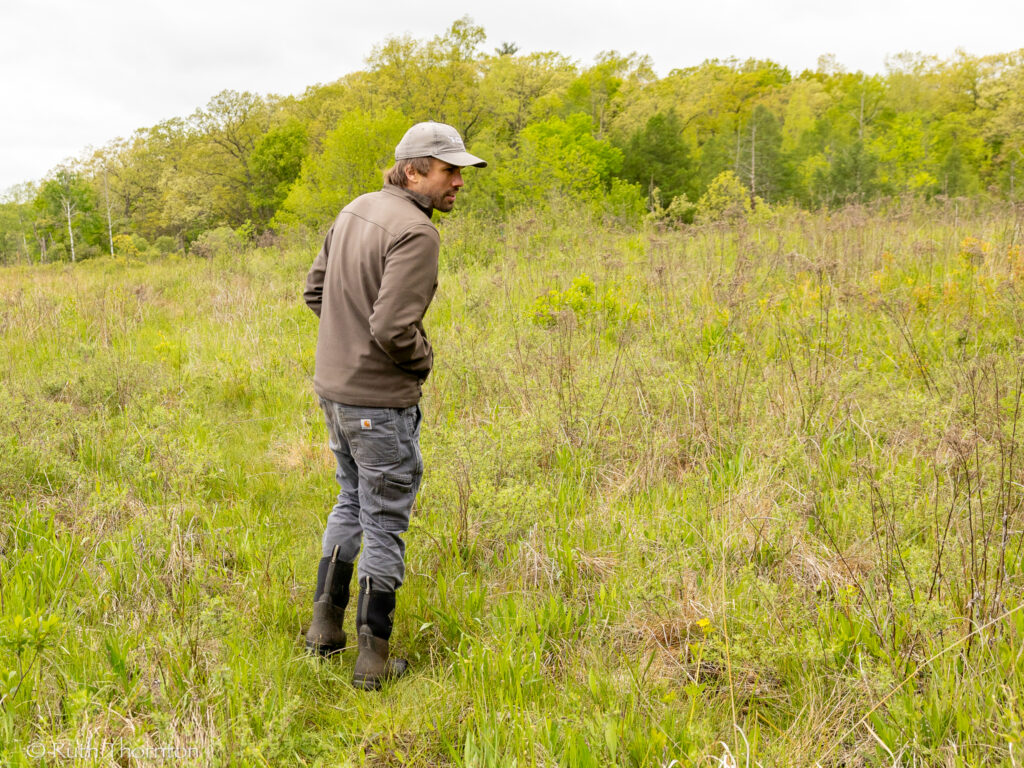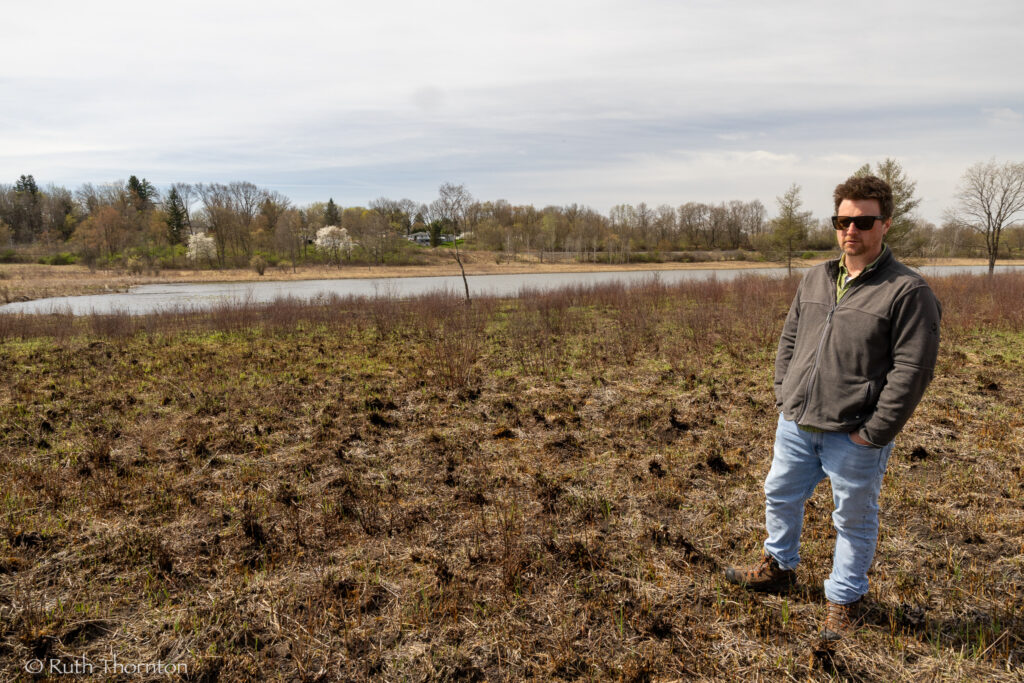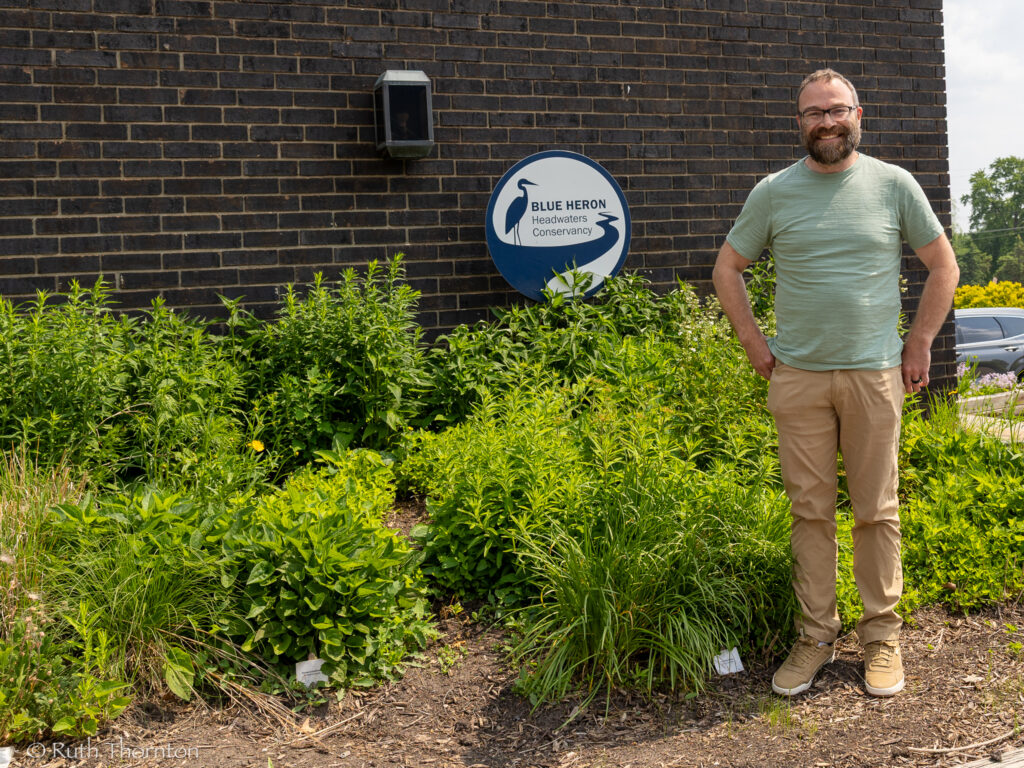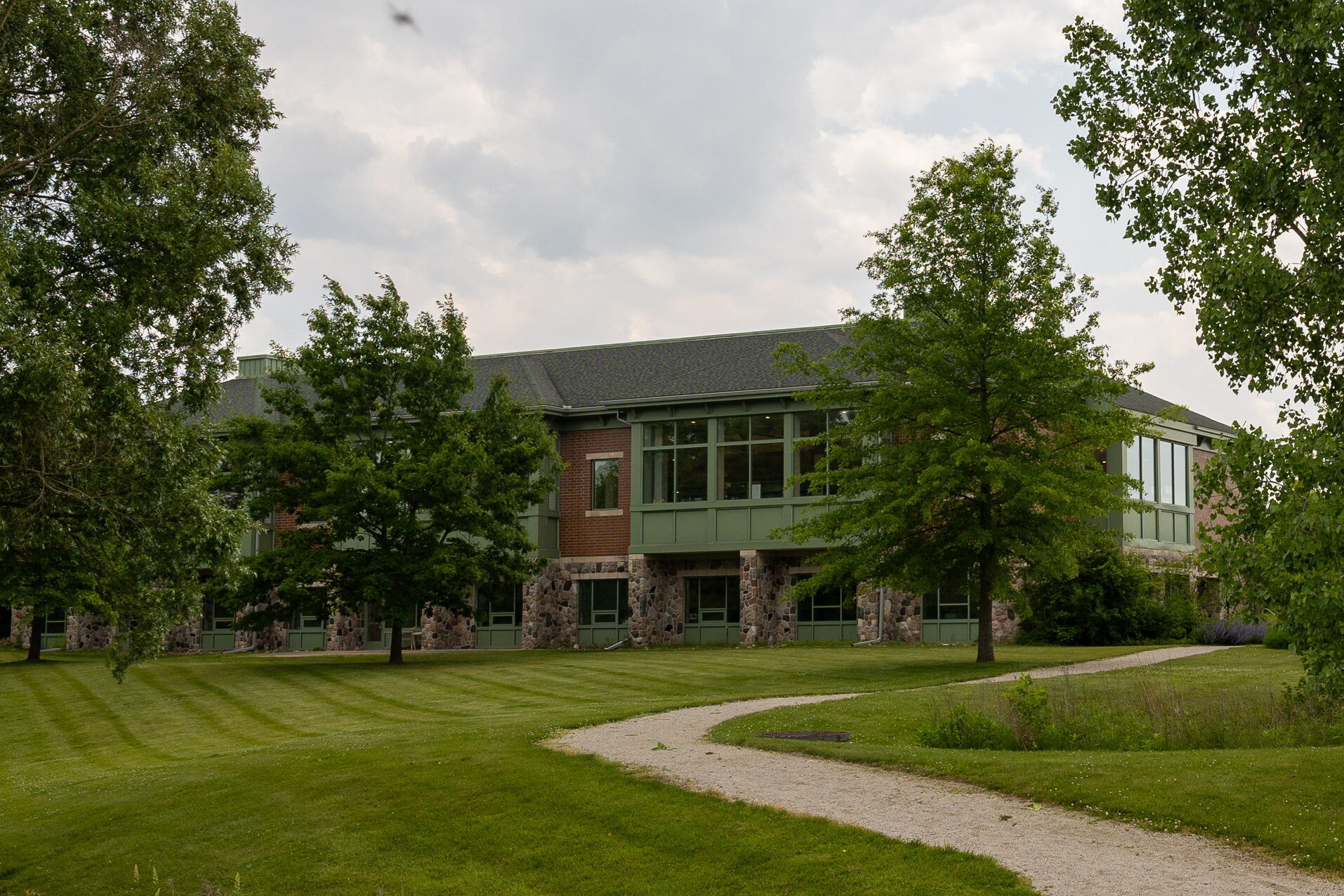
DAVISBURG, MI – Each summer Logan Rowe spends many hours staring at little clumps of grass in a wide field in southeastern Michigan. He is hoping to see tiny green caterpillars that almost perfectly blend in with the grass blades.
Rowe is a zoologist with the Michigan Natural Features Inventory (MNFI), and he is looking for caterpillars of the arguably rarest animal in the state – a small, orange butterfly known as the Poweshiek skipperling.
“Eventually you see it, it just catches your eye,” he said. “They’re really small, tiny this time of year.”
The butterfly was once a common sight on the flowers of midwestern prairies, ranging from southern Canada through Minnesota, the eastern Dakotas, Wisconsin, Illinois and into southeastern Michigan.
Then, about 20 years ago, its numbers started decreasing, finally crashing about 10 years ago. Now it’s found in only two places in the world – Manitoba, Canada and southeastern Michigan.
Rowe is part of a coalition of conservationists and scientists that is racing against the clock to find out what is killing the Poweshiek and how to save it.
The partnership includes different conservation organizations in the U.S. and Canada – state and federal agencies, private nonprofits and zoos.
Another essential member is Springfield Township in Oakland County, home to the last remaining Poweshiek skipperlings outside Canada.
Last remaining Poweshiek skipperling stronghold: Springfield Township, MI
“They’re excellent,” Rowe said, speaking of staff at the township. He described the decades of high-quality natural resources management efforts the township has undertaken to keep its parks and natural areas in top shape.
One driving force behind the expertise was Mike Losey, former natural resources manager for the township. But he left the position for another job in March 2025.
In an April 2024 interview Losey explained the history behind the township’s dedication to its natural areas.
“A lot of the leaders of our community have prioritized some of these special landscapes,” setting aside natural areas for water quality and recreational purposes for decades, Losey said.

The township is at the headwaters, or the beginnings, of two large rivers – the Shiawassee and Huron Rivers, Losey explained. Protecting the areas where the rivers originate supports water quality downstream.
The glacial landscape also created prairie fens, unique wetlands with springs that are fed from groundwater. The fens are very rare in Michigan and often contain many rare species, including Massasauga rattlesnakes and Blanding’s turtles.
“We have the name Springfield in reference to that,” he said.
Losey said many township residents have wells and he thinks they generally understand that they get their water from the same places that feed the wetlands.
Aside from the water quality benefits, “people were recognizing how special this landscape was with all the abundant wildflowers and different species of wildlife,” he said.
Township parks also provide popular recreational opportunities for residents through trails and educational tours.
In the late 1990s and early 2000s the township participated in regional conservation planning meetings to prioritize areas for future acquisition for parks and worked with state and federal agencies to learn about the biology of the natural areas.
“That’s when they first documented the Poweshiek being out here,” Losey said.
At that time the Poweshieks were one of the more common butterflies in the grasslands. When they started to decline in other areas, including its core habitats in Minnesota, they still persisted in some of the township prairie fens.
Scientists are not sure what exactly drove the butterfly’s widespread population collapse, or why they managed to hold on here. A combination of climate change, habitat loss and pesticide use are suspected to be main drivers.
Some studies have found that widespread insecticide spraying against agricultural pests appears to be an important driver of butterfly declines in the Midwest in particular.
The fens where Poweshieks persisted in the township are not surrounded by agriculture, Losey said. “We have this buffer around our habitats where they live that are largely forested or old fields.”
As the butterflies started disappearing further west, they also declined at the last few locations where they were still hanging on, eventually disappearing from all but one site in the township.
Protecting the butterfly’s remaining habitat
Significant challenges remain to prevent the Poweshiek skipperling’s extinction, including protecting enough high quality and intact natural habitat they need to survive.
Susan Julian is the volunteer land specialist and former executive director at Blue Heron Headwaters Conservancy, a non-profit organization that protects land in Springfield Township and surrounding areas.
“People sometimes are discouraged when they hear about the loss of animals,” Julian said. But people can get together and do something about it, she said.
She said she does not hold much hope for the butterfly’s long-term survival if the reasons for their decline are not addressed, including the lack of high-quality habitat.
The conservancy is working toward helping to ensure the persistence of the wetlands the Poweshiek depends on, together with surrounding forests and grasslands. That sometimes means restoring degraded areas by removing invasive species or planting native plants.
Jason Meekhof, the organization’s executive director, said the conservancy recently acquired a key piece of land close to the Poweshiek’s lone remaining site.
While the butterfly is not known to occur on the property now, he is hopeful that it may recolonize it one day.
“We’re going about making our habitat as good as it can be,” he said. “So that when hopefully there’s a bit of recovery, there’s available habitat for those butterflies.”

The land also has habitat for other rare species, “like the Massasauga rattlesnake, Blanding’s turtles, all of those sorts of things that use both wetlands and uplands for just their existence over a yearly span.”
Meekhof said the Poweshiek skipperling is like the canary in the coal mine.
“Being aware of the Poweshiek has led us to understanding that we have potential problems in our backyard,” he said. “And there’s habitat types that are quickly deteriorating or disappearing entirely.”
He thought members of their organization are aware of the Poweshiek and are worried about it, despite the butterfly’s inconspicuous appearance.
“I do get people asking how the butterfly is doing on occasion,” he said.
Many had made donations toward the purchase of the new preserve, and they “definitely know of its existence and are pretty proud that they helped with their donation purchase property that hopefully it can be on one day,” he said.
He said he thinks “people, at heart, care about nature. And the idea that something’s going to blink out on their watch, they don’t want to see that happen. And being able to prevent that makes people feel really good.”
“To think that you’re one of three places right now where this exists, that’s kind of thrilling and scary,” Julian added.
As for the township’s general residents, both Meekhof and Julian don’t think there is a big awareness of the butterfly.
“I think people in general care about nature,” Meekhof said. “They may not specifically know of the tiny little butterfly, but the fact that nature is there is really important to them.”
Park management to support rare species in Springfield Township
Sarah Richmond, director of the township’s Parks and Recreation Department, says residents regularly cite the beauty of the area and peace and quiet as a reason for living here.
Half of the township’s area is low density residential, with nearly a quarter consisting of recreation and conservation uses, according to the township’s 2024 master plan. Only 7% is agricultural.
According to the master plan, the township is considered a “bedroom community,” with most residents employed outside the township border.

The Township is relatively wealthy, with a median household income of over $107,000, compared to Oakland County’s about $92,000 and Michigan’s nearly $70,000, according to the 2020 census.
While Oakland County was one of a handful of Michigan counties where more people voted for Kamala Harris than Donald Trump in the 2024 general election, Springfield Township has been reliably Republican, with 62% of people voting for Trump.
Township residents are also politically more engaged than the county average, with a voter turnout of 77% in the township compared to Oakland County’s 73% and Michigan’s 75% in 2024.
Richmond said her predecessor in the position, Jennifer Tucker, was passionate about the natural resources, initiating the focus on active management.
Starting in the late 1990s Tucker had reached out to biologists at the MNFI and to the Nature Conservancy, a conservation nonprofit, to learn more about the quality of the parks, Richmond said.
“When the Poweshieks were discovered on our property, that was a huge thing,” Richmond said. “Our township park commission is, as they should be, very supportive of all our stewardship efforts that we’ve taken.”
When Tucker left Richmond became park director. “I am very passionate about stewardship activities, but that is not my expertise,” she said.
She worked with the Township Board to hire a dedicated natural resources manager who would be responsible not only for natural resources management at township parks but in the entire township, including providing expertise to private landowners.
“Mike Losey was hired, and he truly has been instrumental in the last 10 years to really take our natural resources program to a whole new level,” Richmond said.
He expanded partnerships with experts to include working with Michigan State University and Oakland University to study the wildlife and natural habitats and wrote grants to support invasive species control and other management efforts.
“We have been very fortunate – because this is such rare land that we have, we’ve been able to work with the DNR, U.S. Fish and Wildlife and several other sources to get some grants for our natural resource activities,” Richmond said.
Many federal and state grants require some sort of match from the recipient, which can be in the form of cash or in-kind services such as labor. Losey worked closely with the grants to ensure the township met all requirements.
Losey, however, left at the end of March 2025 for another position. “He received a great opportunity, and he had to take it” for his and his family’s benefit, she said.
Losey had started several restoration projects that spring that she has now taken over, but she acknowledged that she is juggling both his old responsibilities and her regular duties.
With recent changes in the township’s leadership, however, it appears unlikely that the township board will fill Losey’s position.
Recent turmoil in Springfield Township
“A lot of people are concerned that our current administration in Springfield Township doesn’t place the same value on the natural resources” as prior leadership, said Amy Barnes-Berceli, a township resident.
“They have not filled Mike Losey’s position and seem to have no intent to do so, because they see it as a budget savings mechanism. I think that’s a travesty,” she said.
“I like the rural atmosphere,” she said. “I like getting up in the morning and having deer in my backyard.”
She said that is the general sentiment in the area.
“We like it rural and we want to keep it that way. We value our parks,” she said. “When it comes up for a millage, people vote in favor of protecting them. Knowing the financial straits that we’re in, people still voted on that last millage to protect the parks.”
In the Aug. 6, 2024, primary election, voters overwhelmingly approved renewing the existing township parks and recreation millage for a period of 10 years, from 2024 through 2033, with a vote of 58% for the proposal and 42% against. The millage was estimated to raise more than $600,000 in its first year.
On May 13, 2025, the township board and parks commission held a contentious joint meeting, during which the township supervisor, Richard Davis, surprised the parks commissioners with a proposal to collaborate with Oakland County Parks to manage the township’s natural resources, instead of hiring a dedicated natural resources manager.
According to the meeting minutes, Davis said township expenses had increased, necessitating cost savings. Oakland County parks director Chris Ward attended the meeting and said that any agreement would come at no extra cost to the township.
Parks commissioners expressed concerns about the arrangement during the meeting but agreed to allow Richmond to continue the discussions with Ward to determine if an agreement would be workable, according to the meeting minutes.
Township Treasurer Jamie Dubre said, “the township is facing 50% increases in contract services and wouldn’t be willing to spend money on park projects until the township can recover from the hits (it is) currently taking,” according to the meeting minutes.
Richard Parke, park commissioner for the township, said Losey had brought many proposals to the Park Commission to improve the township’s natural resources through the years.
“Mike was real good at hunting all these things out, bringing them to us and letting us know what would be required of the township to allow that to happen,” Parke said.
But since Losey left his position, the township board has not indicated that they intend to replace his position.
Many board members are new, he said. “There’s a couple of people that have been there for a while, but there’s a lot of new faces on the township board.”
The 2024 election brought in three new township board members out of seven, including a new township supervisor.
The many duties Losey fulfilled will now fall on Richmond, Parke said.
“Along with her normal responsibilities. And she’s wonderful, and I know that she’ll do the best she can,” he said. “But Mike (Losey) did an awful lot for the township and it’s concerning to me as a parks commissioner to see him gone and the position likely not to be refilled.”
Parke said he thinks it’s primarily a funding issue but hadn’t studied the township finances himself to be able to comment further.
Davis, the township supervisor, said the township is facing significant increases in costs, though he stressed that no decisions have been made about next year’s budget yet.
The natural resources are very important to the township, Davis said, and he is aware of the unique environmental conditions and rare species.
“However, there are budget constraints,” he said. “We can’t do everything we want to do.”
He said people in the township realize how incredible the natural resources are, and that’s why he moved here as well.
“It’s like up north, everywhere you drive is beauty,” he said. “This is a jewel.”
Regarding providing matching funds for grants in the future to support the natural resources work, he said he thought that was a possibility, but the budget would determine if the township would be able to continue to do that.
The potential loss of a dedicated natural resources professional is not the only controversy that could affect natural resources management in Springfield Township.
Proposed gravel mine could negatively impact rare prairie wetlands
In May 2025, the planning commission discussed a sand and gravel mining proposal by Michigan-based Burroughs Material Mining company. The company had applied for a special use permit on a more than 400-acre agricultural property along Ormond Road the company has owned for decades.
The proposed mine is less than two miles from the last remaining Poweshiek skipperling site. It is not clear if the mine would cause hydrological changes that could negatively impact the sensitive groundwater-fed prairie fen the butterfly and other rare species depend on.
“There are a lot of community concerns regarding whether that gravel pit should be authorized,” Parke said. “But my specific concerns relate to the changes that it might have on the hydrology in the area, and specifically with respect to the fen.”
He said it will be up to the planning commission and the township board to investigate and address any concerns about potential safety, public health and ecological impacts.
Public meetings addressing the issue have been unusually well attended, he said.
According to meeting minutes, dozens of residents of Springfield Township and adjacent areas expressed their concerns in public comments, with meetings sometimes running past 11 p.m.
“This particular issue seems to be drawing out a lot of interest,” Parke said.
He said residents were decidedly against the proposal. “You’re talking about very large trucks, dozens per day, going in and out, driving on township roads,” he said.
While most of the public comments focus on safety and public health concerns, some comments focus on the potential ecological and hydrological impacts.
Activists have started a petition gathering signatures against the proposal, garnering more than 3,300 signatures as of Aug. 4, 2025. The advocacy website “stop mining in paradise” provides information about the proposal.
Springfield Township provides regular updates on the issue on its website.
Barnes-Berceli said “All sorts of complaints about this mine proposal (have) come forward. It’s currently at the planning commission, and people are complaining that before, previous supervisors would have already put this down as absolutely no.”
What the future holds
At least for the 2025 field season, natural areas management in the township is continuing.
“For this year, we have contractors out working on some prescribed burns. We’ve had them working on woody invasives being removed. We have MNFI coming out” doing Poweshiek surveys, Richmond said.
The township is also still working with the Minnesota Zoo and John Ball Zoo on Poweshiek skipperling management, she said.
The future, however, is uncertain with recent changes in township priorities and budget concerns.
“Funding is always an issue. There’s never enough manpower to do all the work that we really need and want to do,” she said.
If the township is not willing or able to contribute matching funds it may not be eligible to receive some grants.
Similarly, the U.S. administration is no longer as supportive of conservation and science programs as in prior years, so the availability of future federal grants is uncertain.
Rowe, the MNFI zoologist, said he is looking forward to working more with Richmond. “I’m very confident that things will continue moving forward.”
As to why it’s important to protect rare animals like the Poweshiek, he said besides it being a good indicator of the health of the environment, humans have an obligation.
“We’re also probably responsible, in many ways, for the drastic decline of the Poweshiek. Whether it’s habitat conversion or aiding the spread of invasive species, pesticides. It’s probably a little bit of everything. Those are all anthropogenic influences,” he said.
“I think it’s important to take a certain level of accountability and responsibility,” he said. “Because we know that we can save a species from extinction, and so we should do that.”
Rowe said there has been a rebound in Poweshiek skipperling numbers in Michigan since 2022, when only a few butterflies were found in the wild.
With the dedicated work by the township and other international partners, he said, “we have seen an increase in numbers each year. And so hopefully that was the low, and we are only going up from here, fingers crossed.”